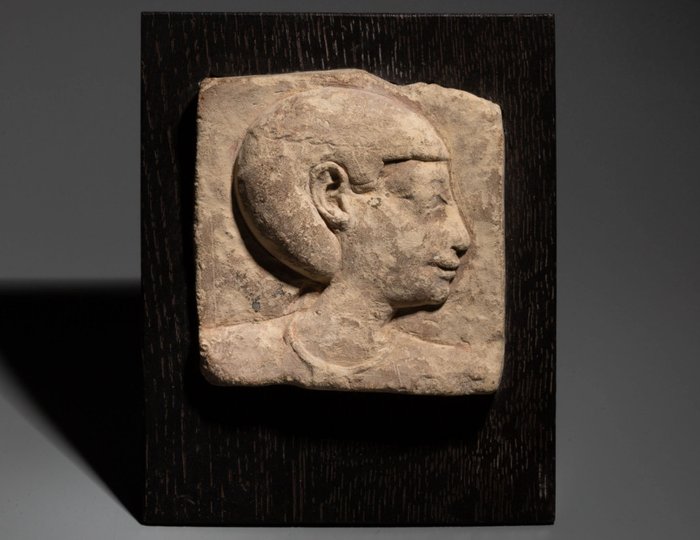
Oud-Egyptisch Kartonnagefragment van een mummie met de god Khnum gevleugeld. 22,5 cm H. Oude herkomst.
Nr. 82727351

Nr. 82727351

Sculptor's Model Relief with Khereduankh (imhotep's mother). Very rare depiction!
Ancient Egypt, Ptolemaic Period, 323 - 30 BC.
Limestone
Height 6.9 cm, 6.6 cm length.
PROVENANCE: Private collection, Switzerland. Acquired around 2000.
CONDITION: Good condition.
Khereduankh, the mother of Imhotep in late beliefs, received divine status like her son. Typically she wears on her short rounded hairstyle the feather crown and double uraei of an Egyptian queen-like goddess, and carries a queen's flywhisk scepter.
Imhotep was an Egyptian chancellor to the Pharaoh Djoser, possible architect of Djoser's step pyramid, and high priest of the sun god Ra at Heliopolis.
These are rectangular plaques or rounded sculptures on a small scale, between thirty and eight centimetres in height, sculpted in white limestone and with one characteristic in common: an unfinished aspect. They are practice or studio pieces, intended to help improve the chiseling technique of the trainee sculptor.
The rounded form Egyptian sculptures are mainly heads or busts of royalty although a small number have been found representing private citizens or deities, while others are simply profiles. Apart from the heads, there are many models of feet, in most cases of the left foot. This is presumably because in Egyptian statues it is this foot and leg which lead as if in forward movement, and therefore the left is the most visible foot. Hands, arms, legs and to a lesser degree, torsos, have also been carved and, many of them, very realistically. In the same way there are animals and parts of animals, above all, the front part. This is the case of the lion: the head of this animal was used during this period of Greek domination as a decorative architectural element. An example of this are the two lion heads found in the back wall of the Dendera Temple. But there are also examples of other animals like the ram, bull, monkey, cat, horse and falcon.
Among the reliefs used as sculptor’s models we find a greater variety of examples. Once more, royal figures are the dominant ones with heads, busts and almost complete figures. But the individual forms of hieroglyphs - animals and birds – are equally common. There can also be found a selection of private individuals, gods (most of which are profiles of goddesses with vulture heads), sacred symbols and parts of bodies. In many cases in which only the head of an animal is depicted, the piece is intended to represent the deity with which the animal is associated. This is evident from the presence of human shoulders, or from the wig that covers the hair or from the extra set of horns over the head, as seen in the relief of the head of the ram god Khnum. This leads us to see divine representations in other animal reliefs where there are no human elements, only those of the animals.
No Egyptian works were left in this incomplete state unless this was done deliberately. Works were always finished. In this typology of models some can be found with wider and straighter chiseling demarcating the forms, while others show no obvious marks from chiseling although the surface is not perfectly smooth and finished. In most of the busts of pharaohs, vertical and horizontal marks can be seen, used by the artisans to mark out in grid form the different parts of the face and in this way to achieve symmetry. In Egyptian art these grids, be they on reliefs or sculptures, are marked out with red or black paint to outline the proportions of the figure following the canon used at that time. These markings disappeared later leaving only the final finished piece visible. There are short lines that mark the location of individual characteristics like eyes, the nose, the mouth, the chin, etc. In many examples these marks are made in the back and lateral sections, to act as a guide during the sculpting of the front area. In pieces depicting royalty in particular these grids are incised and have not been removed, so that the modeling can be clearly seen. This is what most clearly indicates the “practice piece” nature of the work. Further evidence is the lack of painted examples. It was the usual practice for a limestone sculpture to be polychrome, and in the model pieces there is no evidence of such painting at all, not even to mark out lines of expression or concealing the subtleties of the carving. The sculptor did not finish such pieces in polychrome to highlight his work, his design, his hand. This is the clearest evidence that shows that these pieces were for training purposes or to serve the sculptor as a model.
For the Egyptians the representation of an object or an entity in any medium gave it life and was identified with the object or royal personage. This meant that works were never left unfinished unless this was for a specific reason, as is the case when they were carried out as practice so that the artisan could become adept and his work achieve a degree of perfection to the point where he could really be considered a true sculptor.
Notes:
- The piece includes authenticity certificate.
- The piece includes Spanish Export License.
- The seller guarantees that he acquired this piece according to all national and international laws related to the ownership of cultural property. Provenance statement seen by Catawiki.
Zo koop je op Catawiki
1. Ontdek iets bijzonders
2. Plaats het hoogste bod
3. Veilig betalen